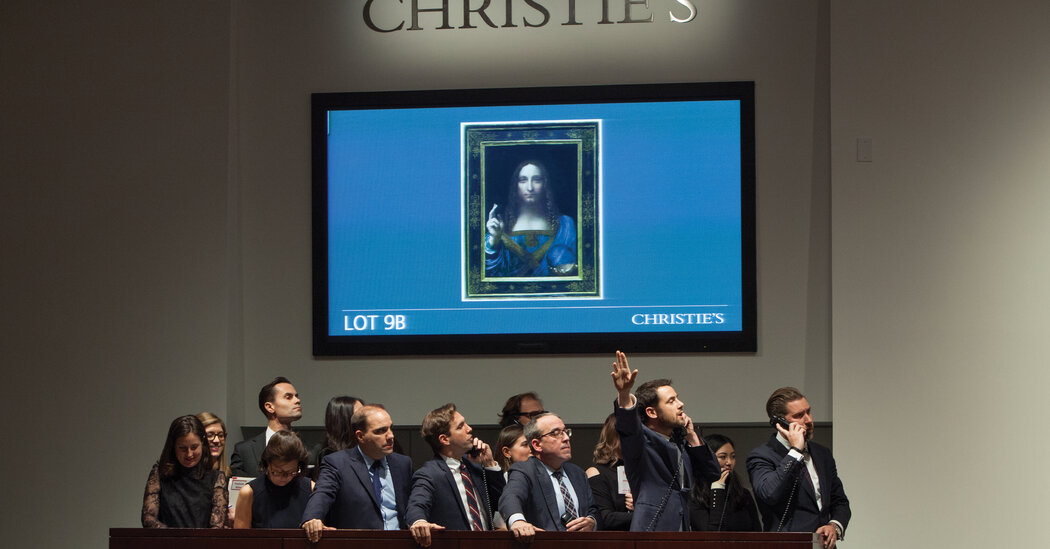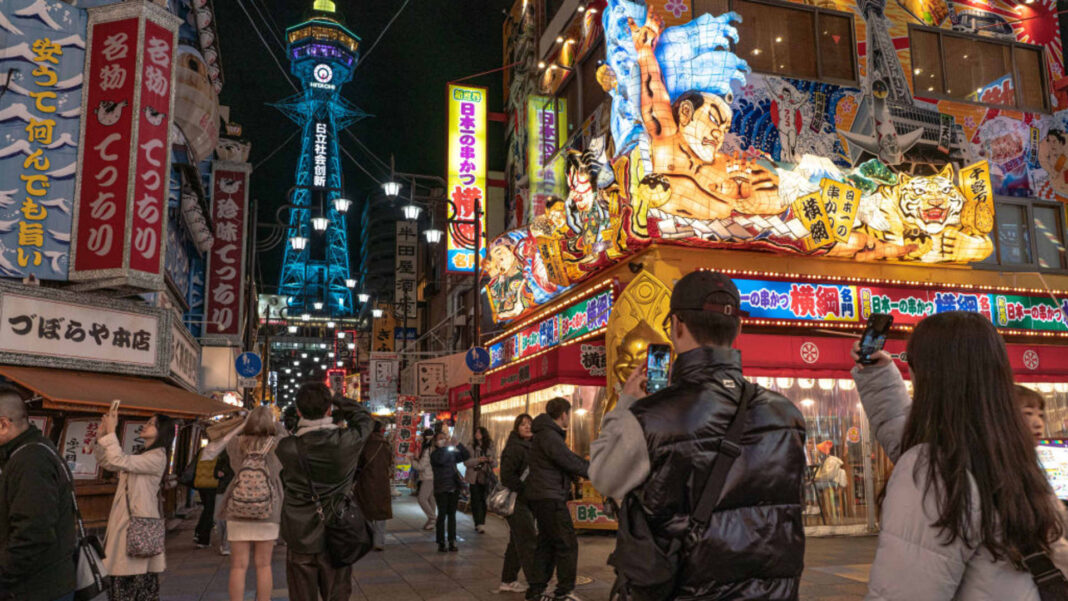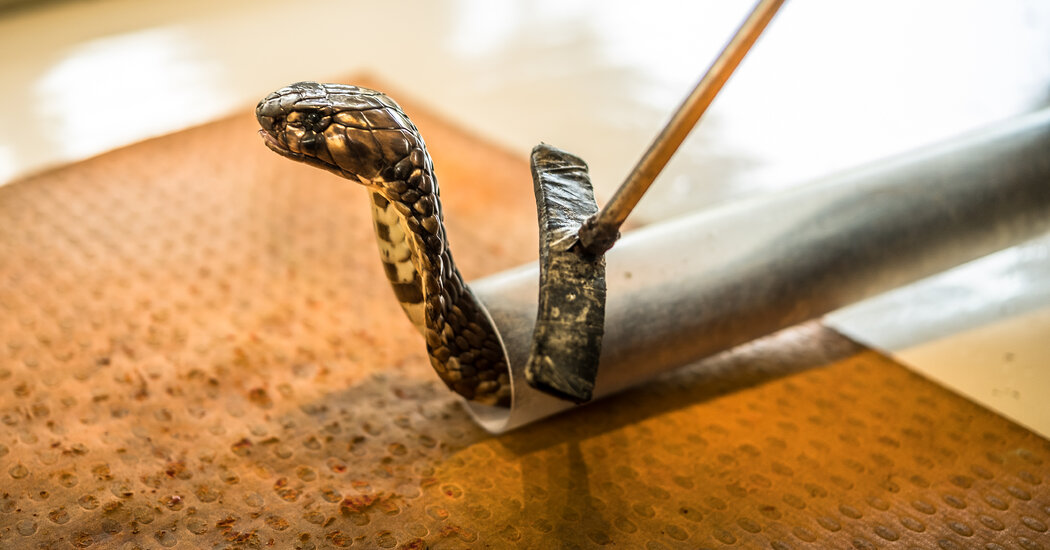When art works fetch spectacular auction prices, like the record $450.3 million for Leonardo da Vinci’s “Salvator Mundi” in 2017, the world’s focus turns for a moment to the arcane goings-on of the international art trade. But with the market in a downturn for the last two years, there have been few attention-grabbing sales at the world’s two biggest and oldest auction houses, Sotheby’s and Christie’s.
An exception came at November’s marquee auctions of modern and contemporary art in New York, when the world’s media — and social media in particular — were momentarily enthralled by the seeming absurdity of a cryptocurrency investor spending $6.2 million at Sotheby’s for a duct-taped banana. But there is a big difference between $6.2 million and $450.3 million.
Sales at Sotheby’s and Christie’s were down for the second year in a row in 2024, according to preliminary figures released by the companies in December. With both supply and demand for big-ticket art in a slump, the auction houses are making major bets on selling luxury goods and niche experiences to make up the shortfall.
Sotheby’s estimated it would have turned over about $6 billion in auction and private sales by year-end, a decline of 24 percent on 2023. Christie’s announced projected aggregate sales of $5.7 billion, down 6 percent year-on-year. Back in 2022, Sotheby’s and Christie’s posted annual turnover of $8 billion and $8.4 billion.
“The auction houses have major problems,” said Christine Bourron, the chief executive of the London-based company Pi-eX, which analyzes art sale results. “They really need to do some thinking about how they can bring some life into their auction business. People who have an interest in art want to have an experience,” added Bourron, who, like many followers of the auction market, finds both Sotheby’s and Christie’s live and online sales increasingly predictable.
Sotheby’s is owned by the French-Israeli telecoms magnate Patrick Drahi, whose beleaguered Altice group is burdened with $60 billion of debt. Sotheby’s deteriorating performance led the auction house to reach out to Abu Dhabi’s sovereign wealth fund, A.D.Q., for a $1 billion cash-for-equity bailout and to lay off more than 100 employees in December. This followed some costly infrastructure decisions: Sotheby’s $100-million purchase of the Breuer Building in New York’s Madison Avenue, the opening of a new headquarters in Paris and the development of a futuristic exhibition and retail space in Hong Kong.
Sotheby’s website now abounds with opportunities to buy pre-owned luxury items at auction or by “instant purchase,” as if in a store, ranging from real estate, classic cars and dinosaur fossils, to smaller prestige collectibles like designer handbags, jewelry, fine wines and game-worn N.B.A. jerseys.
Josh Pullan, Sotheby’s global head of luxury, said sales of such goods draw in wealthy clients who may, in time, start to buy high-end art. “Luxury categories are for us a vital gateway for new, often younger, collectors,” he added.
Last year, luxury generated about 33 percent of sales at Sotheby’s, compared with 16 percent at Christie’s, according to the companies’ communications teams. But the category attracted more buyers than art did.
Guillaume Cerutti, the chief executive of Christie’s, spoke to reporters last month during an end-of-year media call. “Luxury has an advantage, because of the model and the price points,” he said. “Luxury and art will merge with each other,” he added, hinting at future synergies of presentation and categorization.
Christie’s is owned by the luxury goods billionaire François-Henri Pinault, whose Kering conglomerate has also been hit by flagging sales. After introducing handbag auctions back in 2014, Christie’s is now having to catch up with Sotheby’s offering of luxury items and trophy collectibles, like dinosaur skeletons. In September, Christie’s announced that it had reached an agreement to acquire the California-based classic car auctioneers Gooding & Co., setting up a rivalry with Sotheby’s car business, RM Sotheby’s, which last year turned over $887 million in classic auto sales.
“The luxury resale market presents a compelling opportunity for auction houses,” said Daniel Langer, a professor of luxury strategy at Pepperdine University in Malibu, Calif. “Storytelling is a critical success factor in the luxury industry. Auction houses excel in this area — take the recent banana auction as an example,” he added. Sotheby’s marketing, like that of a luxury brand, had skilfully woven a narrative around the sensation that the banana sculpture, by the Italian artist Maurizio Cattelan, created when first exhibited at the Art Basel Miami Beach fair in 2019.
However, this opportunity comes with “significant challenges,” according to Langer. He pointed out that unlike luxury brands, auction houses don’t produce and price all of their own inventory; profit margins on new luxury items are often much higher than their resold equivalents; and unlike conglomerates such as LVMH and Kering, auction houses can’t scale their transactions through a network of retail outlets. These disparities between retail and resale “could limit the overall financial impact of luxury for auction houses,” he said.
Changing spending patterns among the wealthy could also affect demand.
Global sales of luxury flatlined in 2024 for the first time since 2008 (excluding 2020, during the coronavirus pandemic), according to a recent report by the management consultants Bain & Co. The report’s authors said consumers were prioritizing “experiences over products” in these uncertain times and that the luxury goods market, rather like the art market, is suffering from buyer fatigue.
“The super-wealthy in their 30s, 40s and 50s are spending their money on luxury experiences,” said Doug Woodham, a former Christie’s executive who now advises on art-related finance. “That’s money that isn’t being spent on a Matisse drawing,” he added.
“With superluxury experiences, the social cache is so much higher,” said Woodham, who pioneered handbag sales at Christie’s in 2014. “For half a million dollars I can have my 10 best friends on a lavish yacht. They will remember that more than sitting in my house with a Rothko on the wall.”
The global luxury yacht charter market grew to an all-time high of $16.3 billion in 2024, a 6 percent increase on the previous year, according to the Business Research Company. It said that growth has been driven by the popularity of “exclusive and exotic travel destinations” and the “ongoing trend towards experiential luxury.”
In September, Sotheby’s collaborated with the Marriott International hotel chain and the fashion house Alexander McQueen to offer a sealed bid auction, in which bidders can’t see the rival offers. The winner got a two-night stay one of the group’s 5-star London sites as part of an experience that the Sotheby’s website said would “transport guests to where a teenaged McQueen first learned the art of tailoring.” Also included were a five-course fine-dining meal for two, a bespoke tour of London with a private visit to the Victoria & Albert Museum and a personalized photo session with Ann Ray, a longtime McQueen collaborator. Classifying the auction as a private sale, Sotheby’s declined to reveal how much the winning bidder paid for this unique luxury experience, but the presale estimate was $12,000 to $18,000.
Could selling memories, instead of art, be the future of the auction business?



